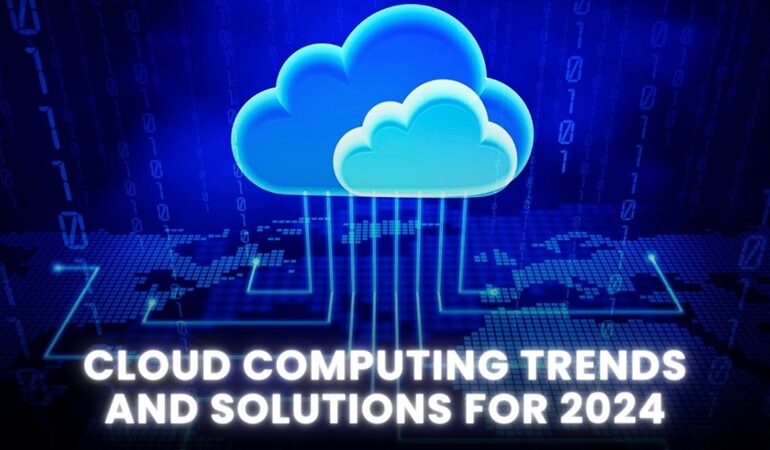Cloud Computing Trends and Solutions for 2024

Cloud computing continues to revolutionize the IT landscape, offering unparalleled scalability, flexibility, and cost-efficiency. As we move into 2024, several trends and innovations are set to redefine the cloud computing ecosystem. This article explores the emerging cloud computing trends and innovative solutions that businesses and IT professionals should watch out for in 2024.
The Rise of AI and Machine Learning Integration
Artificial Intelligence (AI) and Machine Learning (ML) are becoming integral to cloud services. Cloud providers are incorporating AI-driven tools and services to enhance automation, data analysis, and decision-making processes. AI-driven cloud platforms can predict workloads, optimize resources, and provide actionable insights, making them indispensable for businesses looking to leverage data-driven strategies.
The integration of AI with cloud computing has given rise to predictive analytics, enabling businesses to anticipate trends and make informed decisions. Big Data, combined with AI, allows for the processing of vast datasets, uncovering patterns and insights that were previously unattainable. This trend is set to accelerate in 2024, with more organizations adopting AI-powered cloud solutions to gain a competitive edge.
Edge Computing: Bringing Cloud Closer to the User
Edge computing is transforming the way data is processed and delivered. By bringing computation and data storage closer to the location where it is needed, edge computing reduces latency and improves performance. This trend is particularly significant for applications requiring real-time processing, such as IoT devices and autonomous vehicles.
Edge computing also enhances security and privacy by processing data locally, reducing the risk of data breaches during transmission. In 2024, we expect to see a rise in edge computing solutions that offer robust security protocols, catering to industries with stringent data protection requirements, such as healthcare and finance.
Hybrid and Multi-Cloud Strategies
Businesses are increasingly adopting hybrid and multi-cloud strategies to avoid vendor lock-in, increase flexibility, and ensure redundancy. By distributing workloads across multiple cloud environments, organizations can optimize costs, improve performance, and enhance disaster recovery capabilities.
The challenge of managing multiple cloud environments has led to the development of advanced cloud management platforms. These platforms provide seamless integration, centralized control, and unified monitoring of hybrid and multi-cloud infrastructures. In 2024, we anticipate further advancements in these tools, making it easier for businesses to leverage the benefits of multi-cloud strategies.
Serverless Computing: Simplifying Development
Serverless computing, also known as Function as a Service (FaaS), is gaining traction due to its simplicity and cost-effectiveness. Developers can focus on writing code without worrying about the underlying infrastructure. In 2024, we expect an increase in the adoption of serverless architectures, enabling faster development cycles and reduced operational overhead.
Serverless computing is ideal for event-driven applications, microservices, and backend processing tasks. Its scalability and efficiency make it suitable for a wide range of use cases, from simple web applications to complex data processing pipelines. As businesses look for ways to streamline their operations, serverless solutions will become more prevalent.
Enhanced Security Measures
With the increasing complexity of cyber threats, traditional security models are no longer sufficient. The Zero Trust security model, which assumes that threats can come from both inside and outside the network, is gaining popularity. In 2024, more organizations will adopt Zero Trust principles, implementing strict identity verification and continuous monitoring to protect their cloud environments.
Cloud providers are investing heavily in advanced threat detection and response capabilities. These include AI-powered security tools that can identify and mitigate threats in real-time. As cyber-attacks become more sophisticated, the importance of robust security measures in cloud computing cannot be overstated.
Sustainable Cloud Solutions
Environmental sustainability is becoming a priority for cloud providers and users alike. Green cloud computing initiatives focus on reducing energy consumption and minimizing the carbon footprint of data centers. In 2024, we expect to see more cloud providers offering sustainable solutions, such as energy-efficient hardware, renewable energy sources, and carbon offset programs.
Adopting sustainable cloud solutions not only benefits the environment but also offers economic advantages. Energy-efficient data centers can significantly reduce operational costs, while regulatory incentives for using green technologies can provide additional financial benefits. Businesses that prioritize sustainability will find themselves better positioned to meet the demands of eco-conscious consumers and stakeholders.
Quantum Computing and Cloud
Quantum computing is on the horizon, promising to solve complex problems beyond the capabilities of classical computers. Quantum as a Service (QaaS) is emerging as a new offering from cloud providers, allowing businesses to experiment with quantum algorithms and applications. While still in its early stages, QaaS is expected to gain traction in 2024, opening new possibilities for research and innovation.
Industries such as pharmaceuticals, finance, and materials science stand to benefit significantly from quantum computing. By leveraging QaaS, these industries can accelerate drug discovery, optimize financial models, and develop new materials. The integration of quantum computing with cloud services will drive transformative changes across various sectors.
As we look ahead to 2024, the landscape of cloud computing is set to evolve with exciting new trends and innovative solutions. From AI integration and edge computing to hybrid strategies and serverless architectures, these advancements promise to enhance the efficiency, security, and sustainability of cloud services. By staying informed and embracing these trends, businesses can unlock new opportunities and drive growth in the digital age.
FAQs
1. What are the key trends in cloud computing for 2024?
- The key trends in cloud computing for 2024 include AI and machine learning integration, edge computing, hybrid and multi-cloud strategies, serverless computing, enhanced security measures, sustainable cloud solutions, and the emergence of quantum computing.
2. How does edge computing benefit businesses?
- Edge computing benefits businesses by reducing latency, improving performance, enhancing security and privacy, and enabling real-time data processing. It is particularly useful for applications such as IoT devices and autonomous vehicles.
3. What is serverless computing, and why is it important?
- Serverless computing, or Function as a Service (FaaS), allows developers to write and deploy code without managing the underlying infrastructure. It simplifies development, reduces operational overhead, and enables faster development cycles, making it an important trend in cloud computing.
4. How can businesses ensure the security of their cloud environments?
- Businesses can ensure the security of their cloud environments by adopting the Zero Trust security model, implementing advanced threat detection and response capabilities, and continuously monitoring their cloud infrastructure for potential threats.
5. What is Quantum as a Service (QaaS)?
- Quantum as a Service (QaaS) is an offering from cloud providers that allows businesses to experiment with quantum computing algorithms and applications. QaaS is expected to drive innovation and provide new solutions for complex problems in various industries.








